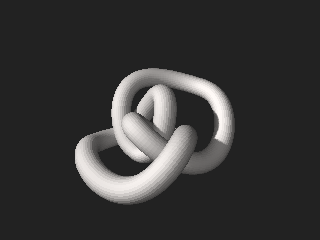
Topology is the branch of mathematics concerned with the properties of a geometric object that are preserved under continuous deformations, such as stretching, twisting, crumpling, and bending; that is, without closing holes, opening holes, tearing, gluing, or passing through itself.

Algebraic topology is a branch of mathematics that uses tools from abstract algebra to study topological spaces. The basic goal is to find algebraic invariants that classify topological spaces up to homeomorphism, though usually most classify up to homotopy equivalence.
In mathematics, homotopy groups are used in algebraic topology to classify topological spaces. The first and simplest homotopy group is the fundamental group, denoted which records information about loops in a space. Intuitively, homotopy groups record information about the basic shape, or holes, of a topological space.
In mathematics, and specifically in topology, a CW complex is a topological space that is built by gluing together topological balls of different dimensions in specific ways. It generalizes both manifolds and simplicial complexes and has particular significance for algebraic topology. It was initially introduced by J. H. C. Whitehead to meet the needs of homotopy theory. CW complexes have better categorical properties than simplicial complexes, but still retain a combinatorial nature that allows for computation.
In mathematics, the Seifert–Van Kampen theorem of algebraic topology, sometimes just called Van Kampen's theorem, expresses the structure of the fundamental group of a topological space in terms of the fundamental groups of two open, path-connected subspaces that cover . It can therefore be used for computations of the fundamental group of spaces that are constructed out of simpler ones.
In mathematics, the Eckmann–Hilton argument is an argument about two unital magma structures on a set where one is a homomorphism for the other. Given this, the structures are the same, and the resulting magma is a commutative monoid. This can then be used to prove the commutativity of the higher homotopy groups. The principle is named after Beno Eckmann and Peter Hilton, who used it in a 1962 paper.
In mathematics, the Hurewicz theorem is a basic result of algebraic topology, connecting homotopy theory with homology theory via a map known as the Hurewicz homomorphism. The theorem is named after Witold Hurewicz, and generalizes earlier results of Henri Poincaré.
In mathematics, and especially in homotopy theory, a crossed module consists of groups and , where acts on by automorphisms (which we will write on the left, , and a homomorphism of groups
The pseudocircle is the finite topological space X consisting of four distinct points {a,b,c,d } with the following non-Hausdorff topology:
In mathematics, higher category theory is the part of category theory at a higher order, which means that some equalities are replaced by explicit arrows in order to be able to explicitly study the structure behind those equalities. Higher category theory is often applied in algebraic topology, where one studies algebraic invariants of spaces, such as the fundamental weak ∞-groupoid.
In mathematics, especially (higher) category theory, higher-dimensional algebra is the study of categorified structures. It has applications in nonabelian algebraic topology, and generalizes abstract algebra.
In mathematics, particularly category theory, a 2-group is a groupoid with a way to multiply objects, making it resemble a group. They are part of a larger hierarchy of n-groups. They were introduced by Hoàng Xuân Sính in the late 1960s under the name gr-categories, and they are also known as categorical groups.
In mathematics, directed algebraic topology is a refinement of algebraic topology for directed spaces, topological spaces and their combinatorial counterparts equipped with some notion of direction. Some common examples of directed spaces are spacetimes and simplicial sets. The basic goal is to find algebraic invariants that classify directed spaces up to directed analogues of homotopy equivalence. For example, homotopy groups and fundamental n-groupoids of spaces generalize to homotopy monoids and fundamental n-categories of directed spaces. Directed algebraic topology, like algebraic topology, is motivated by the need to describe qualitative properties of complex systems in terms of algebraic properties of state spaces, which are often directed by time. Thus directed algebraic topology finds applications in concurrency, network traffic control, general relativity, noncommutative geometry, rewriting theory, and biological systems.
In mathematics, especially in higher-dimensional algebra and homotopy theory, a double groupoid generalises the notion of groupoid and of category to a higher dimension.
Pursuing Stacks is an influential 1983 mathematical manuscript by Alexander Grothendieck. It consists of a 12-page letter to Daniel Quillen followed by about 600 pages of research notes.
In category theory, a branch of mathematics, Grothendieck's homotopy hypothesis states that the ∞-groupoids are spaces.
In algebraic topology, the fundamental groupoid is a certain topological invariant of a topological space. It can be viewed as an extension of the more widely-known fundamental group; as such, it captures information about the homotopy type of a topological space. In terms of category theory, the fundamental groupoid is a certain functor from the category of topological spaces to the category of groupoids.
[...] people still obstinately persist, when calculating with fundamental groups, in fixing a single base point, instead of cleverly choosing a whole packet of points which is invariant under the symmetries of the situation, which thus get lost on the way. In certain situations it is much more elegant, even indispensable for understanding something, to work with fundamental groupoids with respect to a suitable packet of base points, [,,,]
In mathematics, nonabelian algebraic topology studies an aspect of algebraic topology that involves higher-dimensional algebras.
In mathematics, homotopy theory is a systematic study of situations in which maps can come with homotopies between them. It originated as a topic in algebraic topology, but nowadays is learned as an independent discipline.


